Page 88 of 348
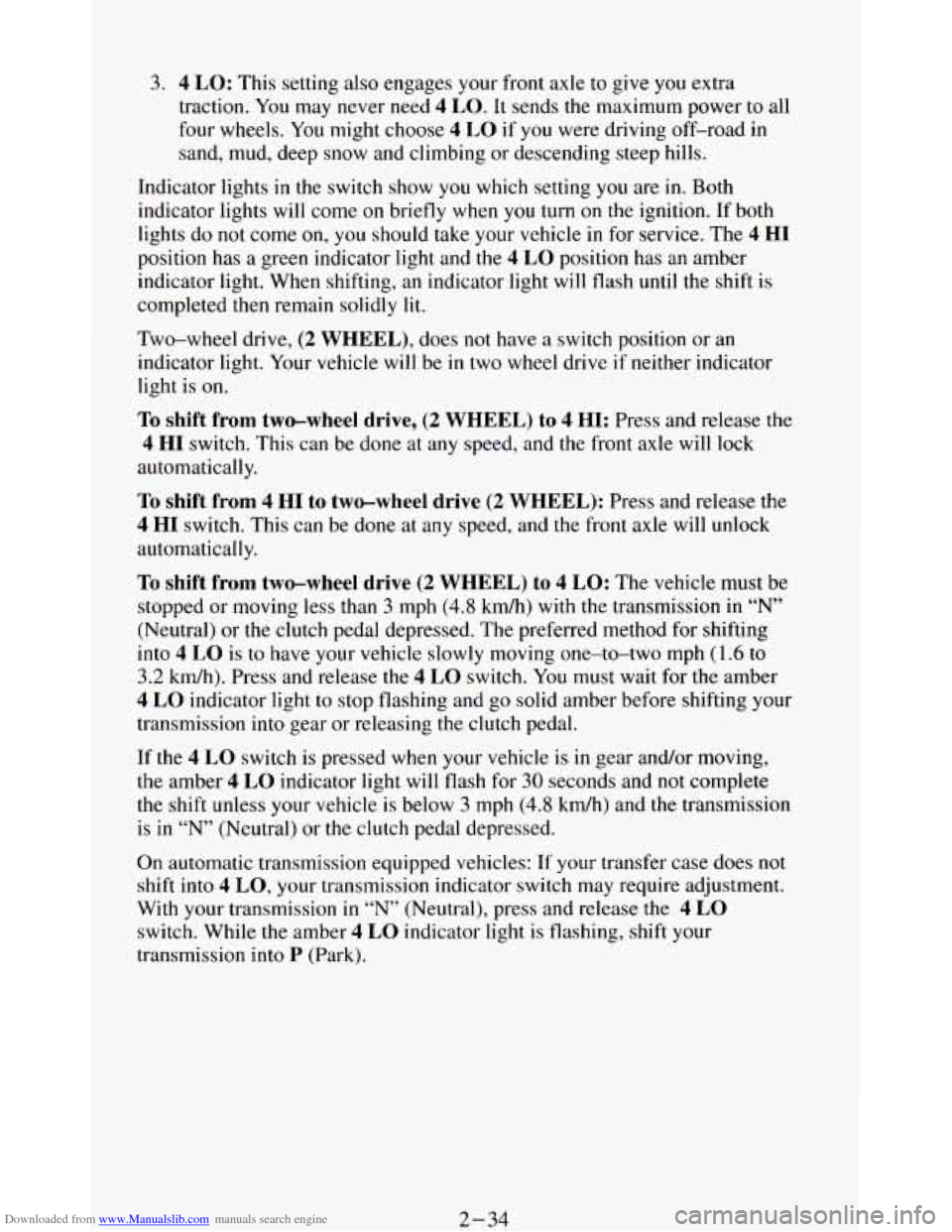
Downloaded from www.Manualslib.com manuals search engine 3. 4 LO: This setting also engages your front axle to give you extra
traction. You may never need
4 LO. It sends the maximum power to all
four wheels.
You might choose 4 LO if you were driving off-road in
sand, mud, deep snow and climbing or descending steep hills.
Indicator lights
in the switch show you which setting you are in. Both
indicator lights will come on briefly when
you turn on the ignition. If both
lights do
not come on, you should take your vehicle in for service. The 4 HI
position has a green indicator light and the 4 LO position has an amber
indicator light. When shifting, an indicator light will flash
until the shift is
completed then remain solidly lit.
Two-wheel drive, (2 WHEEL), does not have a switch position or an
indicator light. Your vehicle will be
in two wheel drive if neither indicator
light is
on.
To shift from two-wheel drive, (2 WHEEL) to 4 HI: Press and release the
4 HI switch. This can be done at any speed, and the front axle will lock
automatically.
To shift from 4 HI to two-wheel drive (2 WHEEL): Press and release the
4 HI switch. This can be done at any speed, and the front axle will unlock
automatically.
To shift from two-wheel drive (2 WHEEL) to 4 LO: The vehicle must be
stopped or moving less than
3 mph (4.8 km/h) with the transmission in “N’
(Neutral) or the clutch pedal depressed. The preferred method for shifting
into
4 LO is to have your vehicle slowly moving one-to-two mph (1.6 to
3.2 kdh). Press and release the 4 LO switch. You must wait for the amber
4 LO indicator light to stop flashing and go solid amber before shifting your
transmission
into gear or releasing the clutch pedal.
If the
4 LO switch is pressed when your vehicle is in gear and/or moving,
the amber
4 LO indicator light will flash for 30 seconds and not complete
the shift unless your vehicle is below
3 mph (4.8 kdh) and the transmission
is in
“N” (Neutral) or the clutch pedal depressed.
On automatic transmission equipped vehicles: If your transfer case does not
shift into
4 LO, your transmission indicator switch may require adjustment.
With your transmission in
“N” (Neutral), press and release the 4 LO
switch. While the amber 4 LO indicator light is flashing, shift your
transmission into
P (Park).
2-34
Page 89 of 348
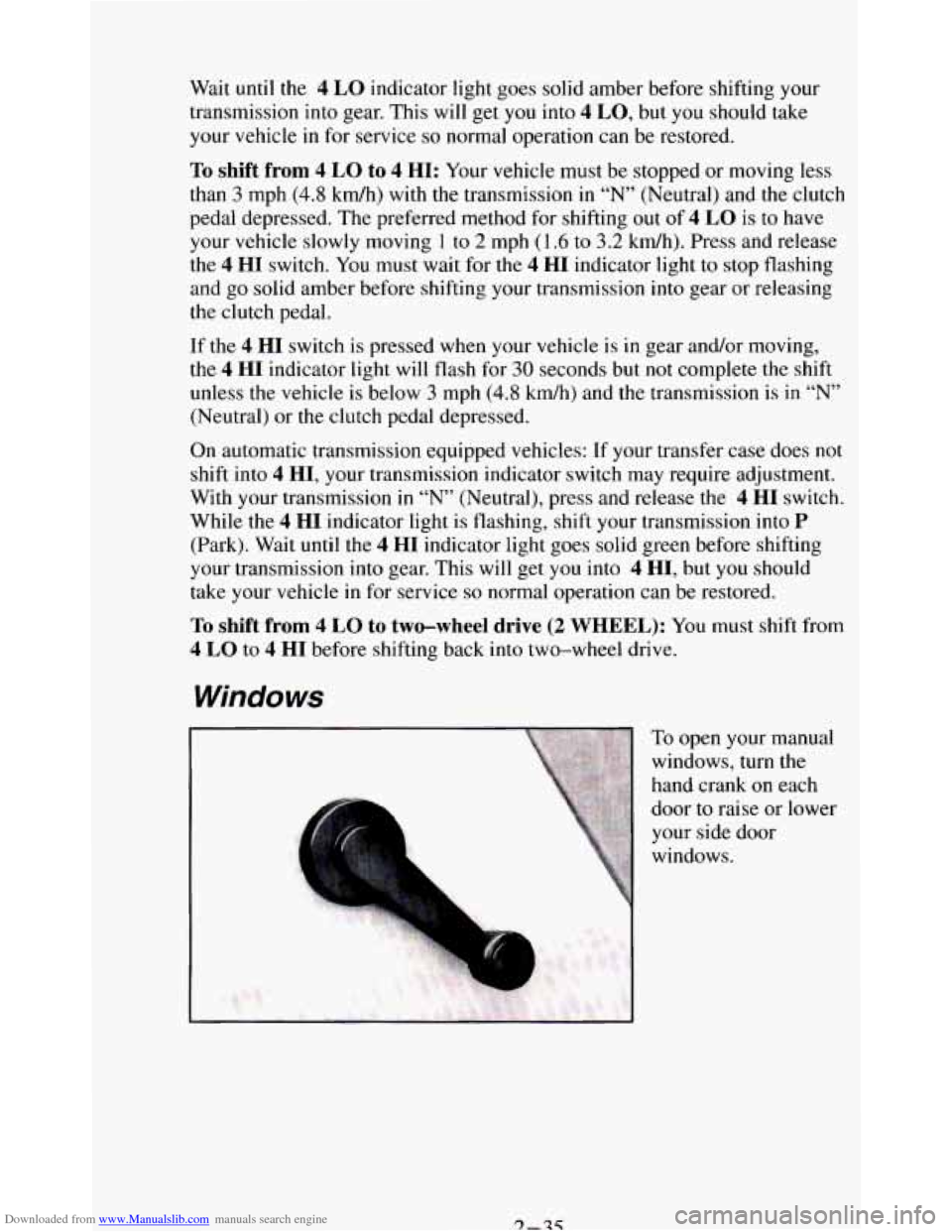
Downloaded from www.Manualslib.com manuals search engine Wait until the 4 LO indicator light goes solid amber before shifting your
transmission into gear. This
will get you into 4 LO, but you should take
your vehicle in for service so normal operation can be restored.
To shift from 4 LO to 4 HI: Your vehicle must be stopped or moving less
than
3 mph (4.8 kdh) with the transmission in “N” (Neutral) and the clutch
pedal depressed. The preferred method for shifting out of
4 LO is to have
your vehicle slowly moving
1 to 2 mph (1.6 to 3.2 kmh). Press and release
the
4 HI switch. You must wait for the 4 HI indicator light to stop flashing
and
go solid amber before shifting your transmission into gear or releasing
the clutch pedal.
If the 4 HI switch is pressed when your vehicle is in gear and/or moving,
the
4 HI indicator light will flash for 30 seconds but not complete the shift
unless the vehicle is below
3 mph (4.8 kdh) and the transmission is in “N”
(Neutral) or the clutch pedal depressed.
On automatic transmission equipped vehicles:
If your transfer case does not
shift into
4 HI, your transmission indicator switch may require adjustment.
With your transmission
in “N” (Neutral), press and release the 4 HI switch.
While the
4 HI indicator light is flashing, shift your transmission into P
(Park). Wait until the 4 HI indicator light goes solid green before shifting
your transmission into gear. This
will get you into 4 HI, but you should
take your vehicle
in for service so normal operation can be restored.
To shift from 4 LO to two-wheel drive (2 WHEEL): You must shift from
4 LO to 4 HI before shifting back into two-wheel drive.
Windows
1
To open your manual
windows,
turn the
hand crank
on each
door to raise or lower
your side door
windows.
Page 98 of 348
Downloaded from www.Manualslib.com manuals search engine Cruise Control (Option)
With Cruise Control, you can maintain a speed of about 25 mph (40 kdh)
or more without keeping your foot
on the accelerator. This can really help
on long trips. Cruise Control does not work at speeds below about 25 mph
(40 kdh).
If you have a manual transmission and you apply your brakes or push the
clutch pedal, the Cruise Control will shut
off.
2-44
Page 112 of 348
Downloaded from www.Manualslib.com manuals search engine Storage Compartments
Your vehicle may
have a console
compartment between
the bucket seats.
To
open it, just lift the top
of the console while
pressing the button
on
the driver’s side.
If you have an automatic transmission, your console includes a handy place
to hold beverage cups.
If you have a manual transmission, your console will
have a tray.
You may also have
storage pockets on the
back
of your power
bucket seats or
60140
split-bench seats.
To open your glove
box, squeeze the
buttons
on either side
of the keyhole
together and pull the
door open.
2-58
Page 128 of 348
Downloaded from www.Manualslib.com manuals search engine Daytime Running Lights (DRL) Indicator Light
(Canada OnIy)
SHIFT Indicator Light
This green DRL
indicator light is
on
the instrument cluster.
The DRL indicator
light is on whenever
the ignition is on and
the headlight switch
and parking brake. are
off. For more details
about
DRL, see
“Lights” in this
section.
This amber
SHIFT
indicator light is on
the instrument cluster
of vehicles with manual transmissions.
The
SHIFT indicator
light will help you get
the best fuel economy.
See “Shift Indicator
Light” in this section.
2-74
Page 176 of 348
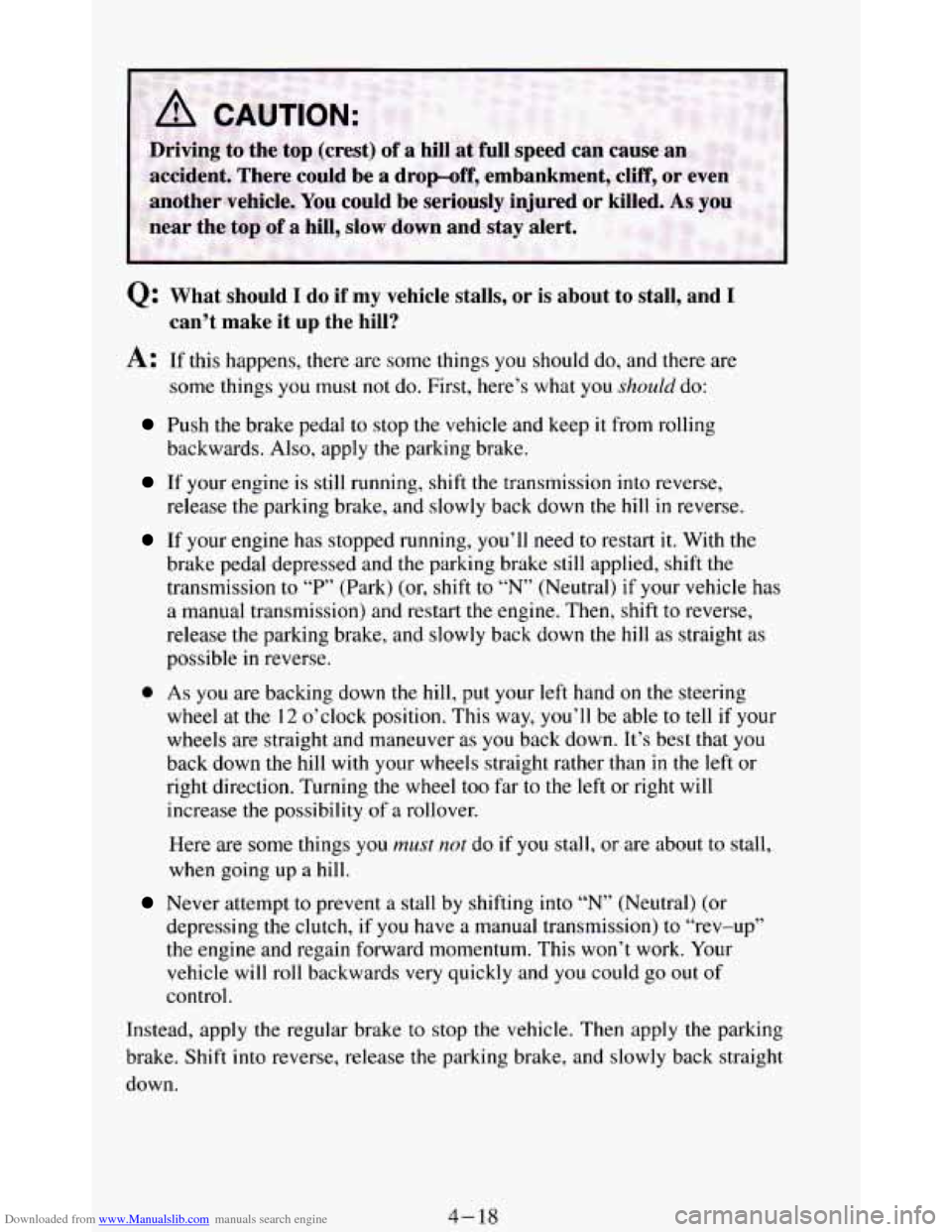
Downloaded from www.Manualslib.com manuals search engine -
1’
Q: What should I do if my vehicle stalls, or is about to stall, and I
A: If this happens, there are some things you should do, and there are
some things
you must not do. First, here’s what you should do:
can’t make it up the hill?
Push the brake pedal to stop the vehicle and keep it from rolling
backwards.
Also, apply the parking brake.
If your engine is still running, shift the transmission into reverse,
release the parking brake, and slowly back down
the hill in reverse.
If your engine has stopped running, you’ll need to restart it. With the
brake pedal depressed and
the parking brake still applied, shift the
transmission
to “P” (Park) (or, shift to “N” (Neutral) if your vehicle has
a manual transmission) and restart the engine. Then, shift to reverse,
release the parking brake, and slowly back down the
hill as straight as
possible in reverse.
wheel at the 12 o’clock position. This way, you’ll be able to tell if your
wheels are straight and maneuver as you back down. It’s best that
you
back down the hill with your wheels straight rather than in the left or
right direction. Turning the wheel too far
to the left or right will
increase the possibility of a rollover.
Here
are some things you must not do if you stall, or are about to stall,
when going up a
hill.
Never attempt to prevent a stall by shifting into “N” (Neutral) (or
depressing the clutch, if
you have a manual transmission) to “rev-up”
the engine and regain forward momentum. This won’t work. Your
vehicle will roll backwards very quickly and
you could go out of
control
.
e As you are backing down the hill, put your left hand on the steering
Instead, apply the regular brake
to stop the vehicle. Then apply the parking
brake. Shift into reverse, release
the parking brake, and slowly back straight
down.
4-18
Page 177 of 348
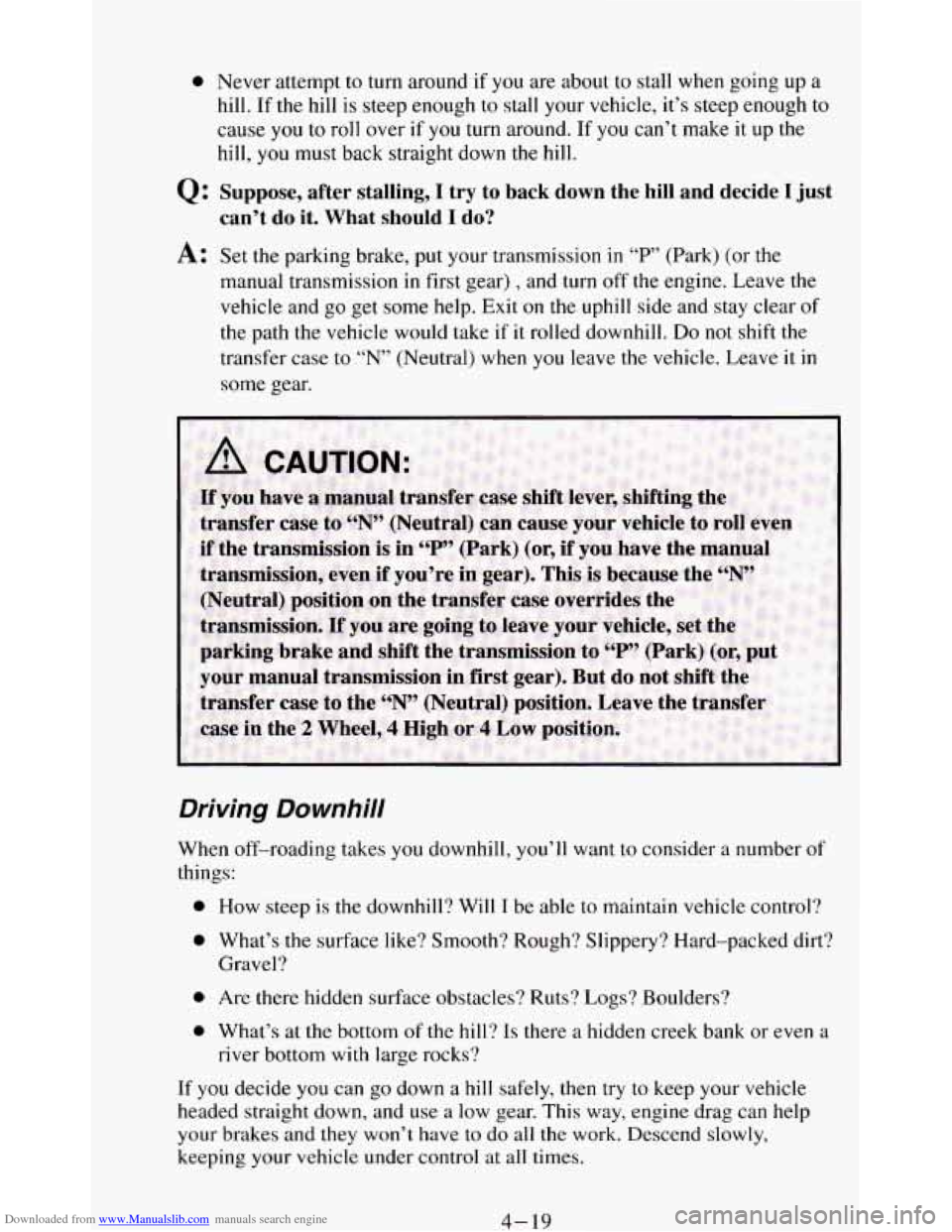
Downloaded from www.Manualslib.com manuals search engine 0 Never attempt to turn around if you are about to stall when going up a
hill. If the hill is steep enough to stall your vehicle, it’s steep enough to
cause
you to roll over if you turn around. If you can’t make it up the
hill, you must back straight down the hill.
Q: Suppose, after stalling, I try to back down the hill and decide I just
can’t do it.
What should I do?
A: Set the parking brake, put your transmission in ‘4P’ (Park) (or the
manual transmission
in first gear) , and turn off the engine. Leave the
vehicle and go get some help. Exit on the uphill side and stay clear of
the path the vehicle would take if it rolled downhill. Do not shift the
transfer case to
“N” (Neutral) when you leave the vehicle. Leave it in
some gear.
Driving Downhill
When off-roading takes you downhill, you’ll want to consider a number of
things:
0 How steep is the downhill? Will I be able to maintain vehicle control?
0 What’s the surface like? Smooth? Rough? Slippery? Hard-packed dirt?
Gravel?
0 Are there hidden surface obstacles? Ruts? Logs? Boulders?
0 What’s at the bottom of the hill? Is there a hidden creek bank or even a
river bottom with large rocks?
If you decide
you can go down a hill safely, then try to keep your vehicle
headed straight down, and use a low gear. This way, engine drag can help
your brakes and they won’t have
to do all the work. Descend slowly,
keeping your vehicle under control at all times.
4- 19
Page 178 of 348
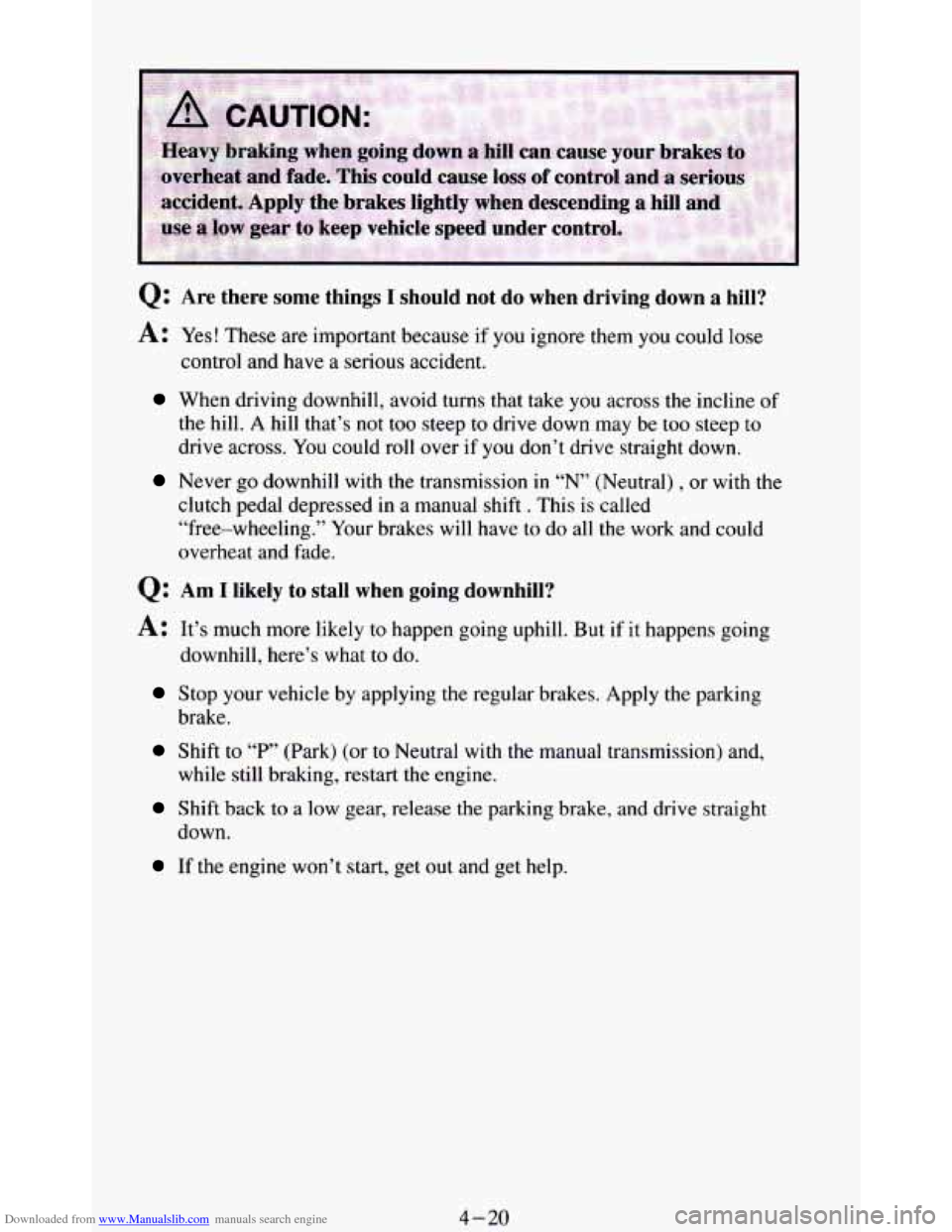
Downloaded from www.Manualslib.com manuals search engine Q: Are there some things I should not do when driving down a hill?
A: Yes! These are important because if you ignore them you could lose
control and have a serious accident.
When driving downhill, avoid turns that take you across the incline of
the
h11. A hill that’s not too steep to drive down may be too steep to
drive across. You could roll over if you don’t drive straight down.
Never go downhill with the transmission in “N” (Neutral) , or with the
clutch pedal depressed
in a manual shift . This is called
“free-wheeling.” Your brakes will have to do all the work and could
overheat and fade.
Q: Am I likely to stall when going downhill?
A: It’s much more likely to happen going uphill. But if it happens going
downhill, here’s what to do.
Stop your vehicle by applying the regular brakes. Apply the parking
brake.
Shift to “P’ (Park) (or to Neutral with the manual transmission) and,
while still braking, restart the engine.
Shift back to a low gear, release the parking brake, and drive straight
down.
If the engine won’t start, get out and get help.
4-20